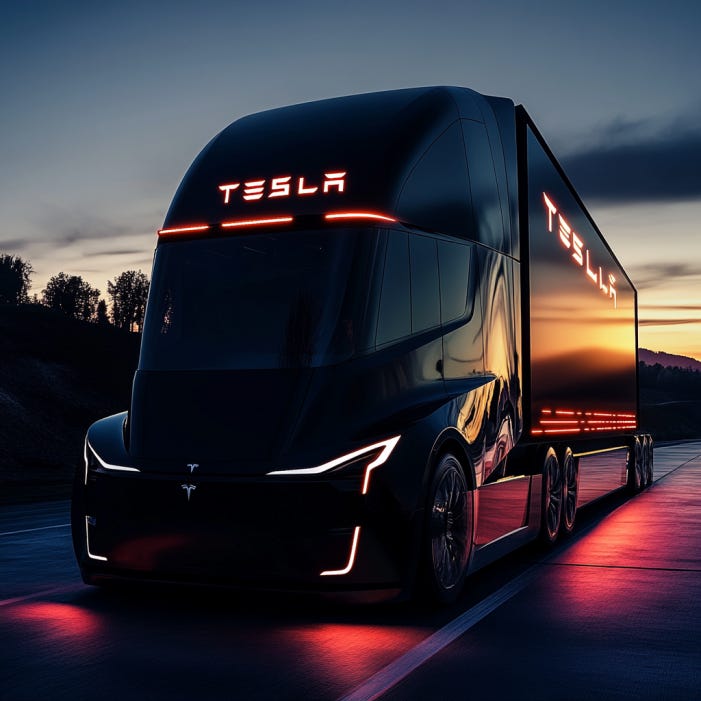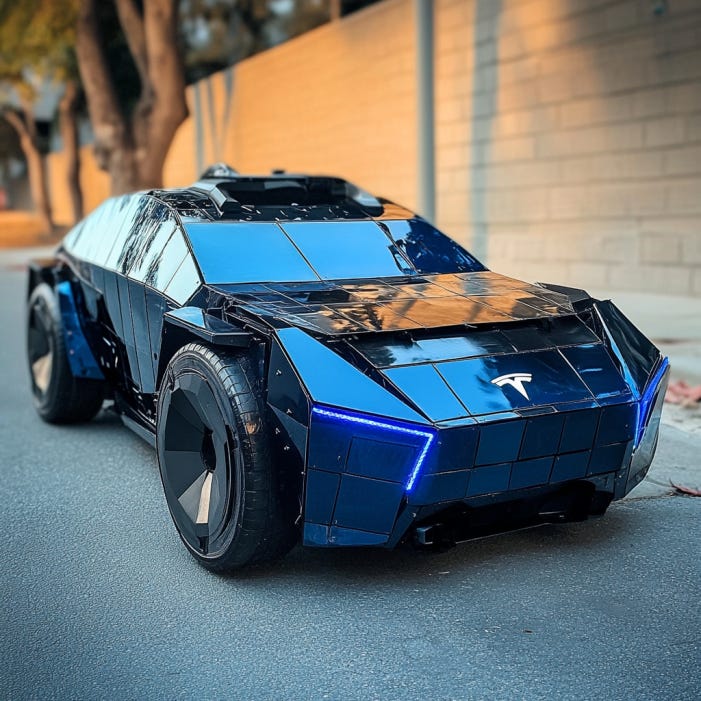Tesla (TSLA) Stock Analysis: Fair Value & Buy-In Targets (Feb 2025 Update)
I analyze Tesla (TSLA) stock to determine "fair value" price of shares and present an optimal buy-in strategy for long-term investors without exposure
Tesla (TSLA) remains one of the most scrutinized names in both the automotive and technology spheres for a variety of reasons, most of which are attributable to the CEO — Elon.
On the one hand, Tesla remains the clear-cut U.S. leader in 100% EVs and energy solutions, boasting enviable brand strength and innovation.
On the other hand, Tesla stock currently trades at high multiples that appear to price in significant future success (e.g., robotaxis, humanoid robots) (TSLA: ~$360 with a ~$1.13T market cap — as of February 2025).
In this report, I evaluate the investment appeal of Tesla (TSLA) over a 5-year horizon (2025-2030) attempting to value Tesla as objectively as possible, balancing both:
Tesla’s current biz fundamentals vs. current valuation metrics
Future TAM potential & odds of realization
Tesla critics point out that the stock price is massively overvalued relative to current (2025) business fundamentals — but many don’t consider the future potential TAM of robotaxis/cybercabs, Dojo, or Optimus (humanoid robots).
Tesla Full Self-Driving (FSD) in 2025: Progress or Biased Data?
Autonomous Vehicles Research: Who’s Winning the L5 FSD Race in 2025?
Tesla bulls (i.e. "all-in” on Tesla) hype FSD, robotaxis, Dojo, Optimus, etc. in a social media circle-jerk and many don’t even understand what market cap means… many would buy Tesla shares trading at $1000/share and claim: really undervalued.
A subset of Tesla bulls are insufferable because they respond to legitimate criticism of Tesla’s valuation with: “Short it then.” Entrenched in stupidity… many don’t understand that even if a stock is overvalued, short positions can backfire (bubbles can always get bigger and/or last longer than expected).
Anyways, Tesla’s annual earnings report for 2024 (10-K) recently dropped, so I did a customized analysis of the following:
Tesla’s Recent Financial & Operating Performance (2024 10-K)
Tesla’s Current Valuation & Future TAM potential
Tesla’s 5-Year 2025-2030 Scenarios (Bull, Bear, Base)
Fair Value Estimates (considering future growth)
Optimal Buy-In Targets & Investment Strategy
This report is for people who: don’t own Tesla but want exposure, existing investors looking to buy more, and/or those who are curious about Tesla and its valuation (what’s “fair value” for Tesla? etc.).
DISCLAIMER: Nothing here is financial or investment advice.
If you want Tesla exposure without excessive risk, you could stick to a rule like only buying after a certain % correction from peak or just go with an ETF (e.g. SPY or QQQM) for diversification.
Tesla’s 2024 Performance (2024 10-K Analysis)
A) Revenue Segment Breakdown (2024)
Automotive (including regulatory credits)
$72.48B (~74% of total revenue).
Growth decelerated compared to prior years; deliveries up ~1% YoY.
Why It Matters: Automotive is Tesla’s core profit engine. Slowing growth and margin compression indicate Tesla’s near-term EV challenges (e.g. price cuts, competition).
Energy Generation & Storage
$10.09B (~10% of total).
+67% YoY (was $6.04B in 2023).
Why It Matters: Reflects Tesla’s push into utility-scale battery (Megapack) and residential storage (Powerwall). Surging revenue and improving margins (19%→26%) show strong secondary growth drivers beyond cars.
Services & Other
$10.53B (~11% of total).
+27% YoY. Covers used-car sales, repairs, paid Supercharging, etc.
Why It Matters: Provides additional revenue streams around Tesla’s growing fleet. As the user base expands, these services should continue to scale.
Automotive Leasing
$1.83B (~2% of total).
Down from $2.12B in 2023.
Why It Matters: Smaller portion now, as Tesla shifts more to direct sales or financing. Leasing still remains for those seeking lower monthly payments or short-term ownership.
B) Financial & Operational Overview
Total Revenue (2024): $97.69B (+1% YoY).
Net Income to Common Stockholders: $7.09B (vs. $14.997B prior year, impacted by margin compression and 2023’s tax items).
Operating Cash Flow: $14.92B, up from $13.26B.
CapEx: $11.34B (vs. $8.90B), illustrating major investments in new factories, AI/robotics, and energy expansions.
Interpretation: Tesla remains profitable with strong cash flow, though automotive margin fell from mid-20s to ~18.4%. Meanwhile, the energy segment soared, helping diversify Tesla beyond cars.
Tesla Stock Valuation Metrics (February 2025)
Tesla’s (TSLA) share price is around $361 (early 2025). Here are 4 widely cited ratios used to evaluate Tesla and other companies. (My in-house analysis is more complex and spans beyond these… but these provide basic insight).
P/E (Price/Earnings) (~177.26)
Tesla’s P/E is notably ~177.26 (exact ratio fluctuates with quarterly earnings).
What It Means: P/E shows how many dollars investors pay for each dollar of earnings. A high P/E often suggests the market expects robust future growth or sees Tesla as a tech disruptor rather than a traditional automaker.
Comparison: Typical automakers often trade at single-digit or low-teens P/E. Tesla’s figure is substantially higher, implying the market believes Tesla’s growth story justifies a massive premium. Big tech peers (MAG7) have notably lower P/E ratios than Tesla (AAPL: 36.25; NVDA: 51.27; MSFT: 33.02; AMZN: 41.44; GOOG: 22.67; META: 29.95).
PEG Ratio (~8.44)
PEG = P/E divided by the company’s near-term EPS growth rate. Typically, a PEG of 1–2 is considered “fair” for a growth company.
Why It Matters: A 8.44 reading implies Tesla’s price is very high relative to how quickly its earnings are forecast to grow. The market may be pricing in major expansions in autonomy, energy, etc.
Comparison: Many growth-oriented companies have PEGs in the 1–3 range. Tesla’s is far above that, raising questions about whether the stock might have overshot near-term fundamentals. (NVIDIA’s is under 1.)
EV/EBITDA (~87.53)
EV/EBITDA compares the enterprise value (market cap plus net debt) to Tesla’s earnings before interest, taxes, depreciation, and amortization.
Why It Matters: This is a popular measure for comparing capital-intensive businesses across different capital structures.
Comparison: A range of 10–20 is typical for large industrials or consumer discretionary firms with growth potential. Tesla’s nearly ~88 figure underscores how richly valued the stock is under standard metrics.
FCF (Free Cash Flow) Yield (~0.31%)
FCF Yield = (Free Cash Flow / Market Cap) × 100%. Tesla’s free cash flow is robust in absolute terms but small compared to its huge market cap.
Why It Matters: A low FCF yield means investors are paying a high price for each dollar of free cash flow. In other words, the market may be anticipating major ramp-ups in future FCF.
Comparison: Many large companies have FCF yields in the 2–5% range. Tesla’s 0.31% is extremely low, again suggesting an elevated valuation.
TSLA Takeaway
Tesla’s multiples are well above most auto and even high-growth large-cap tech.
Fair Value: My internal analysis suggests Tesla is clearly above its near-term fair value if one doesn’t factor in substantial “moonshot” success.
Upshot: The market is pricing Tesla like a potential disruptor in energy, software, and AI—far beyond a standard automaker.
Tesla (TSLA) 5-Year Scenarios: Bull, Bear, & Base (2025-2030)
Below I estimate approximate probabilities for each scenario and 5-year ROI (Return on Investment) from the current TSLA share price of $361.
These probabilities are speculative but aim to be as objective as possible. There is no precise science. You are free to develop your own.
A) Bull Case (~30% Probability)
What Happens:
Tesla attains near-driverless FSD or city-level unsupervised robotaxis in major markets.
Energy storage leaps further, possibly matching the scale of automotive.
Tesla’s brand & technology lead remain unchallenged, sustaining premium multiples.
5-Year ROI: +100–150% (stock could climb to $700–$900).
Confidence: Tied to accelerated breakthroughs in autonomy/regulatory approvals and big wins in Megapack contracts.
B) Bear Case (~20% Probability)
What Happens:
Price wars and competition drive auto margins to low teens or single digits, undermining Tesla’s profitability.
FSD remains driver-supervised for the foreseeable future, no big autonomy windfall.
Valuation multiples compress to more typical auto/industrial levels.
5-Year ROI: -30% to -50% (stock might drop to $180–$250 range).
Confidence: Reflects a confluence of margin pressure and disappointment in “moonshot” claims.
C) Base Case (~50% Probability)
What Happens:
Tesla maintains strong EV brand, moderate margin stability (~15–20%).
Energy continues robust growth but doesn’t completely overshadow auto.
Autonomy remains partially supervised or limited to slow, city-by-city expansions, generating only incremental extra revenue.
5-Year ROI: +40–70% (somewhere in $500–$600 range).
Confidence: No massive “holy grail,” yet Tesla remains a well-run, profitable growth story with ongoing expansions.
Tesla Stock: Fair Value Estimate (Feb 2025)
Given Tesla’s evolving technology roadmap (autonomy, robotics, energy) and current high multiples, it’s difficult to pinpoint a single fair value number.
Instead, I estimate a range that factors in:
Conventional near-term fundamentals (auto + incremental energy)
Partial weighting of potential future expansions (FSD revenue, large-scale robotics, etc.)
Current Price (~$361) vs. Estimated Range
Keep reading with a 7-day free trial
Subscribe to ASAP Drew to keep reading this post and get 7 days of free access to the full post archives.





